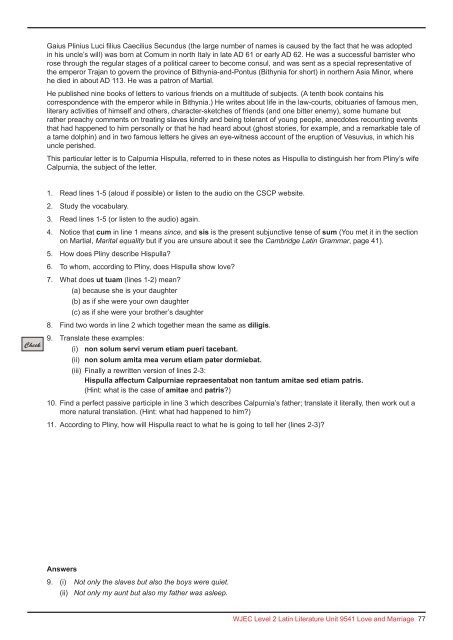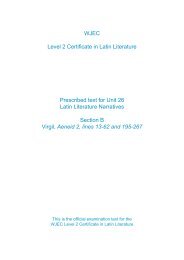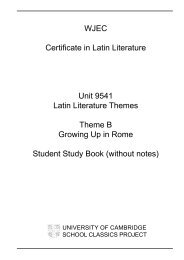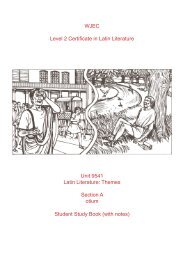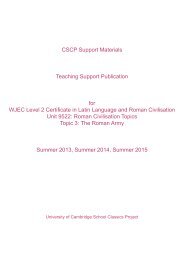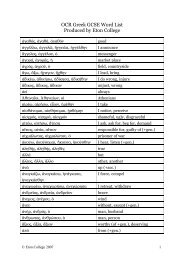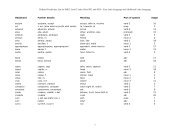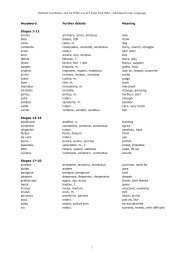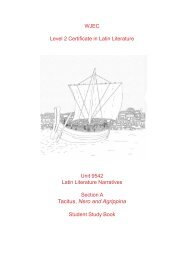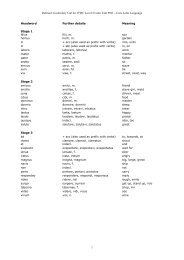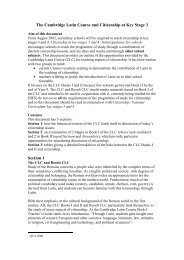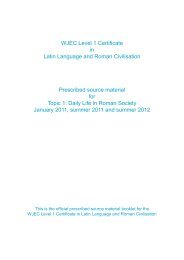Pliny, Letters 4.19, To Calpurnia Hispulla, his wife’s aunt – lines 1-5cum sis pietatis exemplum, filiam fratris tui uttuam diligis, affectumque ei repraesentas, non tantumamitae verum etiam patris amissi. maxime igiturgaudebis, cum cognoveris eam dignam patre, dignamte, dignam avo evadere. 51 cum - sincesum, esse, fui - bepietas, pietatis, f. - dutifulnessexemplum, exempli, n. - example, modelfilia, filiae, f. - daughterfrater, fratris, m. - brothertuus, tua, tuum - your (singular)ut - as2 tuus, tua, tuum - your (singular)diligo, diligere, dilexi, dilectus - loveaffectus, affectus, m. - affection-que - andis, ea, id - he, she, itrepraesento, repraesentare, repraesentavi,repraesentatus - shownon tantum ... verum etiam - not only ... butalso3 amita, amitae, f. - auntverum - butpater, patris, m. - fatheramitto, amittere, amisi, amissus - losemaxime - very greatly, very muchigitur - therefore, and so4 gaudeo, gaudere, gavisus sum - rejoice, bedelightedcum - whencognosco, cognoscere, cognovi, cognitus -learn, find outis, ea, id - he, she, itdignus, digna, dignum + abl. - worthy ofpater, patris, m. - fatherdignus, digna, dignum + abl. - worthy of5 tu, tui - you (singular)dignus, digna, dignum + abl. - worthy ofavus, avi, m. - grandfatherevado, evadere, evasi - turn out76 WJEC Level 2 Latin Literature Unit 9541 Love and Marriage
Gaius Plinius Luci filius Caecilius Secundus (the large number of names is caused by the fact that he was adoptedin his uncle’s will) was born at Comum in north Italy in late AD 61 or early AD 6<strong>2.</strong> He was a successful barrister whorose through the regular stages of a political career to become consul, and was sent as a special representative ofthe emperor Trajan to govern the province of Bithynia-and-Pontus (Bithynia for short) in northern Asia Minor, wherehe died in about AD 113. He was a patron of Martial.He published nine books of letters to various friends on a multitude of subjects. (A tenth book contains hiscorrespondence with the emperor while in Bithynia.) He writes about life in the law-courts, obituaries of famous men,literary activities of himself and others, character-sketches of friends (and one bitter enemy), some humane butrather preachy comments on treating slaves kindly and being tolerant of young people, anecdotes recounting eventsthat had happened to him personally or that he had heard about (ghost stories, for example, and a remarkable tale ofa tame dolphin) and in two famous letters he gives an eye-witness account of the eruption of Vesuvius, in which hisuncle perished.This particular letter is to Calpurnia Hispulla, referred to in these notes as Hispulla to distinguish her from Pliny’s wifeCalpurnia, the subject of the letter.1. Read lines 1-5 (aloud if possible) or listen to the audio on the CSCP website.<strong>2.</strong> <strong>Study</strong> the vocabulary.3. Read lines 1-5 (or listen to the audio) again.4. Notice that cum in line 1 means since, and sis is the present subjunctive tense of sum (You met it in the sectionon Martial, Marital equality but if you are unsure about it see the <strong>Cambridge</strong> Latin Grammar, page 41).5. How does Pliny describe Hispulla?6. To whom, according to Pliny, does Hispulla show love?Check7. What does ut tuam (lines 1-2) mean?(a) because she is your daughter(b) as if she were your own daughter(c) as if she were your brother’s daughter8. Find two words in line 2 which together mean the same as diligis.9. Translate these examples:(i) non solum servi verum etiam pueri tacebant.(ii) non solum amita mea verum etiam pater dormiebat.(iii) Finally a rewritten version of lines 2-3:Hispulla affectum Calpurniae repraesentabat non tantum amitae sed etiam patris.(Hint: what is the case of amitae and patris?)10. Find a perfect passive participle in line 3 which describes Calpurnia’s father; translate it literally, then work out amore natural translation. (Hint: what had happened to him?)11. According to Pliny, how will Hispulla react to what he is going to tell her (lines 2-3)?Answers9. (i) Not only the slaves but also the boys were quiet.(ii) Not only my aunt but also my father was asleep.WJEC Level 2 Latin Literature Unit 9541 Love and Marriage 77
- Page 1:
WJECLevel 2 Certificate in Latin Li
- Page 4:
CIL 1.2.1211, Epitaph to Claudia -
- Page 7 and 8:
NotesWJEC Level 2 Latin Literature
- Page 9 and 10:
20. Read lines 5-8 (aloud if possib
- Page 11 and 12:
Follow your teacher's guidance over
- Page 13 and 14:
13. Read lines 4-8 (aloud if possib
- Page 15 and 16:
NotesWJEC Level 2 Latin Literature
- Page 17 and 18:
28. Read lines 8-11 (aloud if possi
- Page 19 and 20:
NotesWJEC Level 2 Latin Literature
- Page 21 and 22:
47. Read lines 11-14 (aloud if poss
- Page 23 and 24:
61. Read lines 14-18 (aloud if poss
- Page 25 and 26: NotesWJEC Level 2 Latin Literature
- Page 27 and 28: The poems of Catullus, who lived in
- Page 29 and 30: NotesWJEC Level 2 Latin Literature
- Page 31 and 32: 27. Read lines 7-9 (aloud if possib
- Page 33 and 34: 37. Read lines 10-13 (aloud if poss
- Page 36 and 37: Catullus, Poem 8 - lines 1-5miser C
- Page 38 and 39: 18. According to Catullus in line 3
- Page 40 and 41: Catullus, Poem 8 - lines 6-8ibi ill
- Page 42 and 43: Catullus, Poem 8 - lines 9-11nunc i
- Page 44 and 45: Catullus, Poem 8 - lines 12-15vale
- Page 46 and 47: Catullus, Poem 8 - lines 16-19quis
- Page 48 and 49: 82. Translate the last three words
- Page 50 and 51: Catullus, Poem 70nulli se dicit mul
- Page 52 and 53: (ii) The person who ought to do som
- Page 54 and 55: Catullus, Poem 72 - lines 1-4diceba
- Page 56 and 57: Catullus, Poem 72 - lines 5-8nunc t
- Page 58 and 59: Catullus, Poem 83 - lines 1-2Lesbia
- Page 60 and 61: Catullus, Poem 83 - lines 3-6mule,
- Page 62 and 63: 24. et in line 6 is more than just
- Page 64 and 65: Ovid, Ars Amatoria 1.469-478, Advic
- Page 66 and 67: 15. In time, what do these animals
- Page 68 and 69: Ovid, Ars Amatoria 1.469-478, Advic
- Page 70 and 71: 44. What is the literal translation
- Page 72 and 73: Martial, Epigrams 8.12, Marital equ
- Page 74 and 75: CheckCheckCheckTranslate these exam
- Page 78 and 79: Check12. Translate these examples:(
- Page 80 and 81: Pliny, Letters 4.19, To Calpurnia H
- Page 82 and 83: Pliny, Letters 4.19, To Calpurnia H
- Page 84 and 85: allowed in court (see question 30),
- Page 86 and 87: Pliny, Letters 4.19, To Calpurnia H
- Page 88 and 89: Pliny, Letters 4.19, To Calpurnia H
- Page 90 and 91: Pliny, Letters 4.19, To Calpurnia H
- Page 92 and 93: 77. The marriage (like Pliny’s tw
- Page 94 and 95: Pliny, Letters 6.24, Faithful unto
- Page 96 and 97: Pliny, Letters 6.24, Faithful unto
- Page 98 and 99: Check20. Another version of the wif
- Page 100 and 101: Pliny, Letters 6.24, Faithful unto
- Page 102 and 103: The following questions refer to Lo


